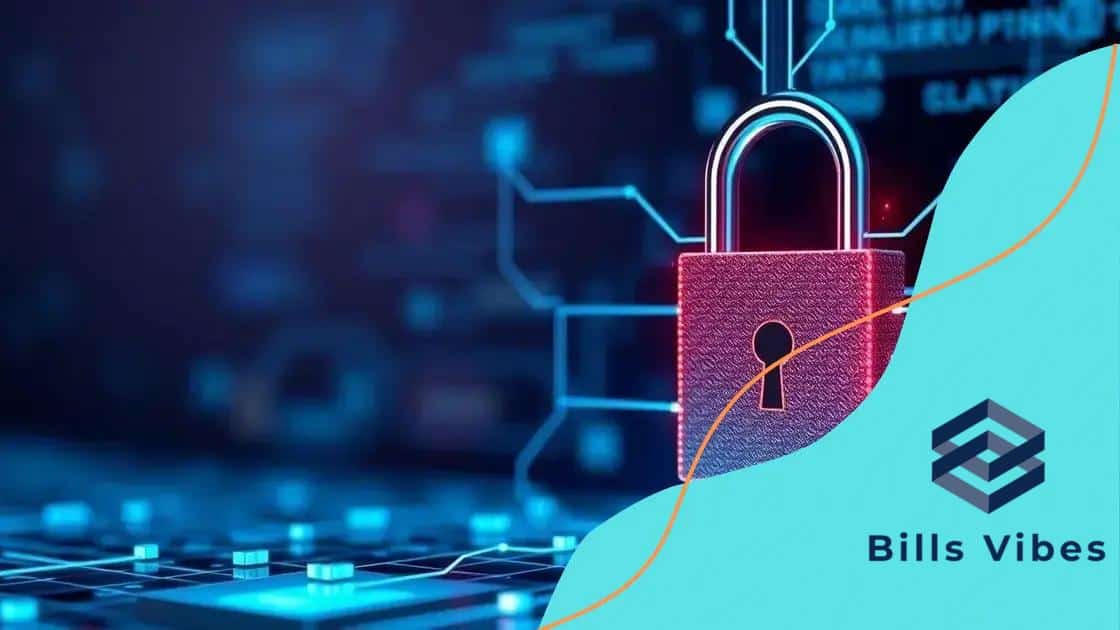Blockchain for student records: transforming education

Blockchain technology revolutionizes education by enhancing data security, enabling personalized learning experiences, and facilitating efficient record management within educational institutions.
Blockchain for student records is reshaping how academic achievements are verified and shared. Imagine having a secure, tamper-proof way to showcase your credentials! Let’s dive into its impact on the educational landscape.
Understanding blockchain technology
Understanding blockchain technology is essential for appreciating its role in modern applications, especially in education. This technology is not just about cryptocurrencies; it offers much more.
What is Blockchain?
At its core, blockchain is a decentralized digital ledger that records transactions across many computers. This ensures that the records cannot be altered retroactively without the consensus of the network. Think of it like a digital notebook that everyone can see but no one can erase.
How Does It Work?
Each set of transactions is bundled into a block, and every block is linked to the previous one, creating a chain. This means that each block contains a unique code, known as a hash, which is produced using cryptographic algorithms. The process of verifying blocks requires significant computational power, making it very secure.
- Decentralized system promotes transparency.
- Security through cryptography protects against fraud.
- Consensus algorithms ensure all copies of the database are accurate.
In education, this technology helps securely store student records, making it easier to verify credentials without the risk of tampering. Schools and universities can have access to verified data in real-time, saving time and resources.
Benefits of Using Blockchain
Implementing blockchain in education comes with several advantages. First, it enhances data security by encrypting student records, making unauthorized access nearly impossible. Second, it streamlines the process of sharing information between institutions, allowing for faster verification of credentials.
- Increases efficiency by reducing paperwork.
- Enhances student privacy with secure data sharing.
- Provides immutable records that can be accessed anytime.
Additionally, it increases trust among stakeholders. When everyone has access to the same information, misunderstandings and disputes are minimized. As more educational institutions adopt this technology, the potential for innovation in how we manage and verify academic achievements continues to grow.
Benefits of blockchain for student records
There are numerous benefits of blockchain for student records. This technology is not just innovative; it changes the way institutions handle important information. One standout feature is enhanced security, which ensures that all records are safe from tampering.
Improved Security
With blockchain, student records are stored in a way that makes them nearly impossible to alter without detection. Each record is encrypted and linked to previous data, creating a chain that is easy to verify. Schools no longer need to worry about unauthorized access to sensitive information.
Efficient Verification Processes
Another key benefit is the efficiency in verifying credentials. When applying for jobs or further education, students can easily share their blockchain-stored records. This means no more waiting for transcripts to be sent or verified. Employers and institutions can instantly validate achievements.
- Reduces time spent on paperwork.
- Quick sharing of information.
- Real-time verification of academic achievements.
This instant access to verified records greatly benefits both students and educational institutions. It allows students to have more control over their records. They can share their information with anyone they choose, whenever they need to, increasing their opportunities.
Cost-Effective Solution
Implementing a blockchain system can ultimately save money for educational institutions. By reducing the need for paper records and manual verification, schools can cut costs associated with administrative work. This efficiency can free up resources to be used in other areas, such as improving educational programs.
- Long-term savings on administrative costs.
- Less need for paper and physical storage.
- Ability to allocate funds to enhance student services.
Furthermore, using blockchain creates trust and transparency. Students feel more secure knowing their information is protected, and schools can build a reputation for being at the forefront of technology in education.
How blockchain improves data security

How blockchain improves data security is a critical topic, especially in our digital age. Data breaches happen all too often, leaving institutions vulnerable. Blockchain technology offers a powerful solution to enhance the security of sensitive information.
Decentralization Matters
One of the key features of blockchain is its decentralized nature. Unlike traditional databases that rely on a central authority, blockchain distributes data across multiple nodes. This makes it much harder for hackers to target a single point of failure.
Immutable Records
Another significant aspect is immutability. Once a record is added to the blockchain, it cannot be changed or deleted. This ensures that all academic records remain accurate and reliable. If any modification is needed, a new block is created rather than altering the original data.
- Reduces the risk of fraud and unauthorized changes.
- Provides a clear audit trail for accountability.
- Builds trust through transparency.
With these features, institutions can confidently store student records, knowing that the data is secure. Blockchain uses encryption to keep information safe from prying eyes. Each transaction is verified through complex algorithms, making unauthorized access extremely difficult.
Data Privacy Enhanced
Learners also benefit from enhanced data privacy. With blockchain, students have control over who can access their records. They can share relevant data with employers or other institutions while keeping personal information private. This balance of security and accessibility is vital.
- Empowers students to manage their own data.
- Eliminates fears of data theft.
- Ensures compliance with privacy regulations.
As educational institutions move towards implementing this technology, the security of student information becomes a priority. The trusted nature of blockchain not only protects sensitive data but also transforms how schools interact with their students.
Challenges in implementing blockchain in education
Implementing blockchain technology in education brings great benefits, but it also comes with several challenges. Understanding these obstacles is crucial for institutions considering this transition.
Technological Barriers
One major challenge is the technological infrastructure. Not all educational institutions have the required hardware and software to support a blockchain system. Upgrading technology can be costly and time-consuming, especially for smaller schools with limited budgets.
Knowledge Gap
Another significant issue is the knowledge gap among staff and administrators. Many educators may not fully understand how blockchain technology works, leading to hesitation in adoption. Professional development and training are essential to bridge this gap.
- Need for specialized training programs.
- Potential resistance from staff unfamiliar with technology.
- Reliance on external tech support or consultants.
Additionally, issues surrounding interoperability arise when trying to integrate blockchain with existing systems. Schools must ensure that blockchain can communicate effectively with other educational technologies. This connectivity is vital for smooth operations.
Regulatory and Compliance Issues
Adhering to regulations is another hurdle. Educational institutions must navigate complex data privacy laws when implementing blockchain for student records. This ensures compliance while still gaining the benefits of increased efficiency and security.
- Varied regulations across different regions.
- Compliance with FERPA and GDPR for data protection.
- Need for clear policies regarding data ownership.
Concerns about security also persist. Although blockchain is generally secure, no system is completely immune to attacks. Institutions need to be aware of potential vulnerabilities and continuously update their protocols to protect sensitive information.
Future trends of blockchain in educational systems
The future of blockchain in educational systems looks very promising. As technology continues to evolve, its application in schools and universities will likely expand, transforming how we manage student information and credentials.
Integration with Artificial Intelligence
One exciting trend is the integration of blockchain with artificial intelligence (AI). This combination can enhance data analysis, enabling educational institutions to gain deeper insights into student performance. With AI, institutions can identify patterns and predict outcomes based on blockchain-stored data.
Personalized Learning Experiences
Another important trend is the focus on personalized learning. By using blockchain, educators can store detailed records of each student’s learning journey. This allows for customized learning paths that cater to individual needs, preferences, and pace.
- Improves student engagement through tailored content.
- Facilitates competency-based education models.
- Enhances feedback mechanisms for students and teachers.
Moreover, as more institutions adopt blockchain, we can expect greater collaboration between schools globally. Shared networks will allow for easier transfer of records and recognition of qualifications. This global connectivity will simplify the process for students who wish to study abroad or transfer to other institutions.
Increased Focus on Data Security
With the growing concern over data privacy, future trends indicate a significant focus on enhancing data security through blockchain technology. As educational systems leverage blockchain, they will adopt even stricter measures to protect sensitive information.
- Development of advanced encryption techniques.
- Implementation of robust compliance frameworks.
- Regular audits to ensure data integrity.
As we look towards the future, the impact of blockchain in education will only continue to grow, helping institutions become more efficient and transparent while enriching the student experience.
In conclusion, the adoption of blockchain technology in education presents exciting opportunities and challenges. As schools and universities explore its potential, the focus on enhanced security, personalized learning, and efficient data management will shape the future of education. By overcoming the obstacles and embracing innovation, educational institutions can pave the way for a transparent and secure learning environment. The evolving landscape of technology will ensure that blockchain plays a significant role in how we manage student records and credentials.
FAQ – Frequently Asked Questions about Blockchain in Education
What are the main benefits of using blockchain in education?
The main benefits include enhanced security, improved data management, and the ability to provide personalized learning experiences.
How does blockchain improve data security?
Blockchain improves data security by creating an immutable ledger that is difficult to alter, ensuring that records remain accurate and protected from unauthorized access.
What challenges do schools face when implementing blockchain?
Schools may face challenges such as technological barriers, a knowledge gap among staff, and compliance with data privacy regulations.
What are future trends for blockchain technology in education?
Future trends include integrating blockchain with AI for better analytics and personalized learning, as well as increasing collaboration between educational institutions.






